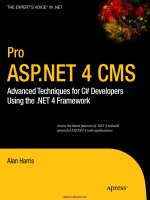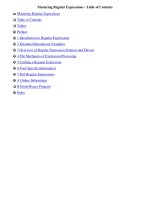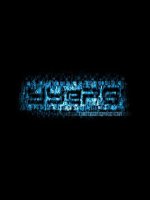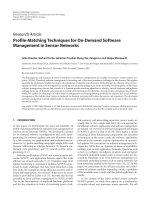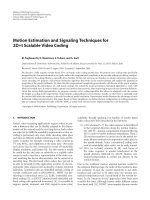c interfaces and implementations techniques for creating reusable software
Bạn đang xem bản rút gọn của tài liệu. Xem và tải ngay bản đầy đủ của tài liệu tại đây (2.96 MB, 533 trang )
Table of Contents
Copyright................................................................................................................................ 1
Addison-Wesley Professional Computing Series..................................................................... 1
Preface................................................................................................................................... 4
Acknowledgments................................................................................................................. 10
Chapter 1. Introduction......................................................................................................... 12
Section 1.1. Literate Programs....................................................................................................................................................................................................... 13
Section 1.2. Programming Style..................................................................................................................................................................................................... 19
Section 1.3. Efficiency.................................................................................................................................................................................................................... 22
Further Reading............................................................................................................................................................................................................................ 23
Exercises........................................................................................................................................................................................................................................ 24
Chapter 2. Interfaces and Implementations.......................................................................... 26
Section 2.1. Interfaces.................................................................................................................................................................................................................... 26
Section 2.2. Implementations....................................................................................................................................................................................................... 29
Section 2.3. Abstract Data Types.................................................................................................................................................................................................. 32
Section 2.4. Client Responsibilities............................................................................................................................................................................................... 35
Section 2.5. Efficiency.................................................................................................................................................................................................................... 41
Further Reading............................................................................................................................................................................................................................. 41
Exercises........................................................................................................................................................................................................................................ 42
Chapter 3. Atoms.................................................................................................................. 44
Section 3.1. Interface..................................................................................................................................................................................................................... 44
Section 3.2. Implementation......................................................................................................................................................................................................... 45
Further Reading............................................................................................................................................................................................................................. 53
Exercises........................................................................................................................................................................................................................................ 53
Chapter 4. Exceptions and Assertions................................................................................... 56
Section 4.1. Interface..................................................................................................................................................................................................................... 58
Section 4.2. Implementation......................................................................................................................................................................................................... 64
Section 4.3. Assertions.................................................................................................................................................................................................................. 70
Further Reading............................................................................................................................................................................................................................. 74
Exercises........................................................................................................................................................................................................................................ 75
Chapter 5. Memory Management.......................................................................................... 78
Section 5.1. Interface..................................................................................................................................................................................................................... 80
Section 5.2. Production Implementation...................................................................................................................................................................................... 84
Section 5.3. Checking Implementation......................................................................................................................................................................................... 87
Further Reading............................................................................................................................................................................................................................ 96
Exercises........................................................................................................................................................................................................................................ 97
Chapter 6. More Memory Management............................................................................... 100
Section 6.1. Interface.................................................................................................................................................................................................................... 101
Section 6.2. Implementation....................................................................................................................................................................................................... 103
Further Reading........................................................................................................................................................................................................................... 109
Exercises....................................................................................................................................................................................................................................... 111
Chapter 7. Lists.................................................................................................................... 114
Section 7.1. Interface.................................................................................................................................................................................................................... 114
Section 7.2. Implementation........................................................................................................................................................................................................ 119
Further Reading........................................................................................................................................................................................................................... 124
Exercises....................................................................................................................................................................................................................................... 125
Chapter 8. Tables................................................................................................................ 126
Section 8.1. Interface................................................................................................................................................................................................................... 126
Section 8.2. Example: Word Frequencies................................................................................................................................................................................... 129
Section 8.3. Implementation....................................................................................................................................................................................................... 136
Further Reading........................................................................................................................................................................................................................... 143
Exercises...................................................................................................................................................................................................................................... 144
Chapter 9. Sets.................................................................................................................... 148
Section 9.1. Interface................................................................................................................................................................................................................... 149
Section 9.2. Example: Cross-Reference Listings......................................................................................................................................................................... 151
Section 9.3. Implementation....................................................................................................................................................................................................... 159
Further Reading........................................................................................................................................................................................................................... 169
Exercises...................................................................................................................................................................................................................................... 169
Chapter 10. Dynamic Arrays................................................................................................ 172
Section 10.1. Interfaces................................................................................................................................................................................................................ 173
Section 10.2. Implementation...................................................................................................................................................................................................... 176
Further Reading.......................................................................................................................................................................................................................... 180
Exercises...................................................................................................................................................................................................................................... 180
Chapter 11. Sequences......................................................................................................... 182
Section 11.1. Interface.................................................................................................................................................................................................................. 182
Section 11.2. Implementation...................................................................................................................................................................................................... 185
C Interfaces and Implementations: Techniques for Creating Reusable Software. C Interfaces and Implementations: Techniques for Creating Reusabl
Prepared for , Frank Liu
Copyright © 1997 by David R. Hanson.. This download file is made available for personal use only and is subject to the Terms of Service. Any other use requires prior written consent from
the copyright owner. Unauthorized use, reproduction and/or distribution are strictly prohibited and violate applicable laws. All rights reserved.
Further Reading........................................................................................................................................................................................................................... 191
Exercises....................................................................................................................................................................................................................................... 191
Chapter 12. Rings................................................................................................................ 194
Section 12.1. Interface.................................................................................................................................................................................................................. 194
Section 12.2. Implementation..................................................................................................................................................................................................... 198
Further Reading.......................................................................................................................................................................................................................... 207
Exercises...................................................................................................................................................................................................................................... 208
Chapter 13. Bit Vectors........................................................................................................ 210
Section 13.1. Interface.................................................................................................................................................................................................................. 210
Section 13.2. Implementation...................................................................................................................................................................................................... 213
Further Reading.......................................................................................................................................................................................................................... 224
Exercises...................................................................................................................................................................................................................................... 224
Chapter 14. Formatting....................................................................................................... 226
Section 14.1. Interface.................................................................................................................................................................................................................. 227
Section 14.2. Implementation..................................................................................................................................................................................................... 235
Further Reading.......................................................................................................................................................................................................................... 249
Exercises...................................................................................................................................................................................................................................... 250
Chapter 15. Low-Level Strings............................................................................................. 252
Section 15.1. Interface.................................................................................................................................................................................................................. 254
Section 15.2. Example: Printing Identifiers................................................................................................................................................................................ 260
Section 15.3. Implementation..................................................................................................................................................................................................... 262
Further Reading........................................................................................................................................................................................................................... 275
Exercises...................................................................................................................................................................................................................................... 276
Chapter 16. High-Level Strings........................................................................................... 280
Section 16.1. Interface................................................................................................................................................................................................................. 280
Section 16.2. Implementation..................................................................................................................................................................................................... 287
Further Reading.......................................................................................................................................................................................................................... 304
Exercises...................................................................................................................................................................................................................................... 305
Chapter 17. Extended-Precision Arithmetic........................................................................ 308
Section 17.1. Interface................................................................................................................................................................................................................. 308
Section 17.2. Implementation...................................................................................................................................................................................................... 314
Further Reading.......................................................................................................................................................................................................................... 332
Exercises...................................................................................................................................................................................................................................... 333
Chapter 18. Arbitrary-Precision Arithmetic........................................................................ 334
Section 18.1. Interface................................................................................................................................................................................................................. 334
Section 18.2. Example: A Calculator........................................................................................................................................................................................... 338
Section 18.3. Implementation..................................................................................................................................................................................................... 345
Further Reading.......................................................................................................................................................................................................................... 364
Exercises...................................................................................................................................................................................................................................... 365
Chapter 19. Multiple-Precision Arithmetic.......................................................................... 368
Section 19.1. Interface................................................................................................................................................................................................................. 369
Section 19.2. Example: Another Calculator................................................................................................................................................................................ 376
Section 19.3. Implementation..................................................................................................................................................................................................... 384
Further Reading........................................................................................................................................................................................................................... 413
Exercises....................................................................................................................................................................................................................................... 413
Chapter 20. Threads............................................................................................................ 416
Section 20.1. Interfaces................................................................................................................................................................................................................ 419
Section 20.2. Examples............................................................................................................................................................................................................... 429
Section 20.3. Implementations................................................................................................................................................................................................... 442
Further Reading........................................................................................................................................................................................................................... 474
Exercises...................................................................................................................................................................................................................................... 476
Interface Summary............................................................................................................. 480
AP................................................................................................................................................................................................................................................. 481
Arena........................................................................................................................................................................................................................................... 482
Arith............................................................................................................................................................................................................................................. 483
Array............................................................................................................................................................................................................................................ 483
ArrayRep...................................................................................................................................................................................................................................... 484
Assert........................................................................................................................................................................................................................................... 485
Atom............................................................................................................................................................................................................................................ 485
Bit................................................................................................................................................................................................................................................. 485
Chan............................................................................................................................................................................................................................................. 487
Except.......................................................................................................................................................................................................................................... 487
Fmt.............................................................................................................................................................................................................................................. 488
List............................................................................................................................................................................................................................................... 489
Mem............................................................................................................................................................................................................................................. 490
MP................................................................................................................................................................................................................................................ 491
Ring.............................................................................................................................................................................................................................................. 494
Sem.............................................................................................................................................................................................................................................. 495
Seq............................................................................................................................................................................................................................................... 496
Set................................................................................................................................................................................................................................................ 497
C Interfaces and Implementations: Techniques for Creating Reusable Software. C Interfaces and Implementations: Techniques for Creating Reusabl
Prepared for , Frank Liu
Copyright © 1997 by David R. Hanson.. This download file is made available for personal use only and is subject to the Terms of Service. Any other use requires prior written consent from
the copyright owner. Unauthorized use, reproduction and/or distribution are strictly prohibited and violate applicable laws. All rights reserved.
Stack............................................................................................................................................................................................................................................ 498
Str................................................................................................................................................................................................................................................ 498
Table............................................................................................................................................................................................................................................. 501
Text.............................................................................................................................................................................................................................................. 502
Thread.......................................................................................................................................................................................................................................... 504
XP................................................................................................................................................................................................................................................. 505
Bibliography....................................................................................................................... 508
...................................................................................................................................................................................................................................................... 515
bvdindexIndex..................................................................................................................... 515
C Interfaces and Implementations: Techniques for Creating Reusable Software. C Interfaces and Implementations: Techniques for Creating Reusabl
Prepared for , Frank Liu
Copyright © 1997 by David R. Hanson.. This download file is made available for personal use only and is subject to the Terms of Service. Any other use requires prior written consent from
the copyright owner. Unauthorized use, reproduction and/or distribution are strictly prohibited and violate applicable laws. All rights reserved.
Addison-Wesley Professional Computing Series
Brian W. Kernighan, Consulting Editor
Ken Arnold/John Peyton, A C User’s Guide to ANSI C
Tom Cargill, C++ Programming Style
William R. Cheswick/Steven M. Bellovin, Firewalls and Internet Security: Repelling
the Wily Hacker
David A. Curry, UNIX® System Security: A Guide for Users and System
Administrators
Erich Gamma/Richard Helm/Ralph Johnson/John Vlissides, Design Patterns:
Elements of Reusable Object-Oriented Software
David R. Hanson, C Interfaces and Implementations: Techniques for Creating
Reusable Software
John Lakos, Large Scale C++ Software Design
Scott Meyers, Effective C++: 50 Specific Ways to Improve Your Programs and
Designs
Scott Meyers, More Effective C++: 35 New Ways to Improve Your Programs and
Designs
Robert B. Murray, C++ Strategies and Tactics
David R. Musser/Atul Saini, STL Tutorial and Reference Guide: C++ Programming
with the Standard Template Library
John K. Ousterhout, Tcl and the Tk Toolkit
Craig Partridge, Gigabit Networking
J. Stephen Pendergrast Jr., Desktop KornShell Graphical Programming
Radia Perlman, Interconnections: Bridges and Routers
David M. Piscitello/A. Lyman Chapin, Open Systems Networking: TCP/IP and OSI
Stephen A. Rago, UNIX® System V Network Programming
Curt Schimmel, UNIX® Systems for Modern Architectures: Symmetric
Multiprocessing and Caching for Kernel Programmers
W. Richard Stevens, Advanced Programming in the UNIX® Environment
W. Richard Stevens, TCP/IP Illustrated, Volume 1: The Protocols
W. Richard Stevens, TCP/IP Illustrated, Volume 3: TCP for Transactions, HTTP,
NNTP, and the UNIX Domain Protocols
Gary R. Wright/W. Richard Stevens, TCP/IP Illustrated, Volume 2: The
Implementation
C Interfaces and Implementations: Techniques for Creating Reusable Software. C Interfaces and Implementations: Techniques for Creating Reusabl
Prepared for , Frank Liu
Copyright © 1997 by David R. Hanson.. This download file is made available for personal use only and is subject to the Terms of Service. Any other use requires prior written consent from
the copyright owner. Unauthorized use, reproduction and/or distribution are strictly prohibited and violate applicable laws. All rights reserved.
C INTERFACES
AND
IMPLEMENTATIONS
Licensed by
Techniques
Frank for
LiuCreating
Reusable Software
1740749
David R. Hanson
Princeton University
▲
▼▼
ADDISON-WESLEY
An imprint of Addison Wesley Longman, Inc.
Reading, Massachusetts • Harlow, England • Menlo Park, California
Berkeley, California • Don Mills, Ontario • Sydney
Bonn • Amsterdam • Tokyo • Mexico City
C Interfaces and Implementations: Techniques for Creating Reusable Software. C Interfaces and Implementations: Techniques for Creating Reusabl
Prepared for , Frank Liu
Copyright © 1997 by David R. Hanson.. This download file is made available for personal use only and is subject to the Terms of Service. Any other use requires prior written consent from
the copyright owner. Unauthorized use, reproduction and/or distribution are strictly prohibited and violate applicable laws. All rights reserved.
This book was prepared from camera-ready copy supplied by the author.
Many of the designations used by manufacturers and sellers to distinguish their
products are claimed as trademarks. Where those designations appear in this
book and Addison Wesley Longman, Inc. was aware of a trademark claim, the
designations have been printed in initial caps or all caps.
The authors and publishers have taken care in the preparation of this book, but
make no expressed or implied warranty of any kind and assume no responsibility
for errors or omissions. No liability is assumed for incidental or consequential
damages in connection with or arising out of the use of the information or
programs contained herein.
The publisher offers discounts on this book when ordered in quantity for special
sales.
For more information, please contact:
Corporate & Professional Publishing Group
Addison Wesley Longman, Inc.
One Jacob Way
Reading, Massachusetts 01867
Library of Congress Cataloging-in-Publication Data
Hanson, David R.
C interfaces and implementations : techniques for creating
reusable software / David R. Hanson.
p.
cm. –– (Addison-Wesley professional computing series)
Includes bibliographical references and index.
ISBN 0-201-49841-3 (pbk.)
1. C (Computer program language)
2. Computer software–
–Reusability
I. Title.
II. Series.
QA76.73.C15H37
1996
005.13'3––dc20
96-28817
CIP
Copyright © 1997 by David R. Hanson.
All rights reserved. No part of this publication may be reproduced, stored in a
retrieval system, or transmitted, in any form, or by any means, electronic,
mechanical, photocopying, recording, or otherwise, without the prior written
permission of the publisher.
Printed in the United States of America. Published simultaneously in Canada.
Text design by Wilson Graphics & Design (Kenneth J. Wilson).
Text printed on recycled and acid-free paper.
ISBN 0-201-49841-3
2 3 4 5 6 7 8 9 10-MA-00999897
Second printing, January 1997
C Interfaces and Implementations: Techniques for Creating Reusable Software. C Interfaces and Implementations: Techniques for Creating Reusabl
Prepared for , Frank Liu
Copyright © 1997 by David R. Hanson.. This download file is made available for personal use only and is subject to the Terms of Service. Any other use requires prior written consent from
the copyright owner. Unauthorized use, reproduction and/or distribution are strictly prohibited and violate applicable laws. All rights reserved.
PREFACE
P
rogrammers are inundated with information about application programming interfaces, or APIs. Yet, while most programmers use
APIs and the libraries that implement them in almost every application they write, relatively few create and disseminate new, widely
applicable, APIs. Indeed, programmers seem to prefer to “roll their own”
instead of searching for a library that might meet their needs, perhaps
because it is easier to write application-specific code than to craft welldesigned APIs.
I’m as guilty as the next programmer: lcc, a compiler for ANSI/ISO C
written by Chris Fraser and myself, was built from the ground up. (lcc is
described in A Retargetable C Compiler: Design and Implementation,
Addison-Wesley, 1995.) A compiler exemplifies the kind of application
for which it is possible to use standard interfaces and to create interfaces that are useful elsewhere. Examples include interfaces for memory
management, string and symbol tables, and list manipulation. But lcc
uses only a few routines from the standard C library, and almost none of
its code can be used directly in other applications.
This book advocates a design methodology based on interfaces and
their implementations, and it illustrates this methodology by describing
24 interfaces and their implementations in detail. These interfaces span
a large part of the computing spectrum and include data structures,
arithmetic, string processing, and concurrent programming. The implementations aren’t toys — they’re designed for use in production code. As
described below, the source code is freely available.
There’s little support in the C programming language for the interfacebased design methodology. Object-oriented languages, like C++ and
Modula-3, have language features that encourage the separation of an
interface from its implementation. Interface-based design is independent
of any particular language, but it does require more programmer willpower and vigilance in languages like C, because it’s too easy to pollute
an interface with implicit knowledge of its implementation and vice
versa.
xi
C Interfaces and Implementations: Techniques for Creating Reusable Software. C Interfaces and Implementations: Techniques for Creating Reusabl
Prepared for , Frank Liu
Copyright © 1997 by David R. Hanson.. This download file is made available for personal use only and is subject to the Terms of Service. Any other use requires prior written consent from
the copyright owner. Unauthorized use, reproduction and/or distribution are strictly prohibited and violate applicable laws. All rights reserved.
xii
PREFACE
Once mastered, however, interface-based design can speed development time by building upon a foundation of general-purpose interfaces
that can serve many applications. The foundation class libraries in some
C++ environments are examples of this effect. Increased reuse of existing
software — libraries of interface implementations — reduces initial
development costs. It also reduces maintenance costs, because more of
an application rests on well-tested implementations of general-purpose
interfaces.
The 24 interfaces come from several sources, and all have been
revised for this book. Some of the interfaces for data structures —
abstract data types — originated in lcc code, and in implementations of
the Icon programming language done in the late 1970s and early 1980s
(see R. E. Griswold and M. T. Griswold, The Icon Programming Language,
Prentice Hall, 1990). Others come from the published work of other programmers; the “Further Reading” sections at the end of each chapter give
the details.
Some of the interfaces are for data structures, but this is not a data
structures book, per se. The emphasis is more on algorithm engineering
— packaging data structures for general use in applications — than on
data-structure algorithms. Good interface design does rely on appropriate data structures and efficient algorithms, however, so this book complements traditional data structure and algorithms texts like Robert
Sedgewick’s Algorithms in C (Addison-Wesley, 1990).
Most chapters describe one interface and its implementation; a few
describe related interfaces. The “Interface” section in each chapter gives
a concise, detailed description of the interface alone. For programmers
interested only in the interfaces, these sections form a reference manual.
A few chapters include “Example” sections, which illustrate the use of
one or more interfaces in simple applications.
The “Implementation” section in each chapter is a detailed tour of the
code that implements the chapter’s interface. In a few cases, more than
one implementation for the same interface is described, which illustrates
an advantage of interface-based design. These sections are most useful
for those modifying or extending an interface or designing related interfaces. Many of the exercises explore design and implementation alternatives. It should not be necessary to read an “Implementation” section in
order to understand how to use an interface.
The interfaces, examples, and implementations are presented as literate programs; that is, the source code is interleaved with its explanation
in an order that best suits understanding the code. The code is extracted
automatically from the text files for this book and assembled into the
C Interfaces and Implementations: Techniques for Creating Reusable Software. C Interfaces and Implementations: Techniques for Creating Reusabl
Prepared for , Frank Liu
Copyright © 1997 by David R. Hanson.. This download file is made available for personal use only and is subject to the Terms of Service. Any other use requires prior written consent from
the copyright owner. Unauthorized use, reproduction and/or distribution are strictly prohibited and violate applicable laws. All rights reserved.
ORGANIZATION
xiii
order dictated by the C programming language. Other book-length examples of literate programming in C include A Retargetable C Compiler and
The Stanford GraphBase: A Platform for Combinatorial Computing by
D. E. Knuth (Addison-Wesley, 1993).
Organization
The material in this book falls into the following broad categories:
Foundations
1.
2.
4.
5.
6.
Introduction
Interfaces and Implementations
Exceptions and Assertions
Memory Management
More Memory Management
Data Structures
7.
8.
9.
10.
11.
12.
13.
Lists
Tables
Sets
Dynamic Arrays
Sequences
Rings
Bit Vectors
Strings
3.
14.
15.
16.
Atoms
Formatting
Low-Level Strings
High-Level Strings
Arithmetic
17. Extended-Precision Arithmetic
18. Arbitrary-Precision Arithmetic
19. Multiple-Precision Arithmetic
Threads
20. Threads
Most readers will benefit from reading all of Chapters 1 through 4,
because these chapters form the framework for the rest of the book. The
remaining chapters can be read in any order, although some of the later
chapters refer to their predecessors.
Chapter 1 covers literate programming and issues of programming
style and efficiency. Chapter 2 motivates and describes the interfacebased design methodology, defines the relevant terminology, and tours
two simple interfaces and their implementations. Chapter 3 describes
C Interfaces and Implementations: Techniques for Creating Reusable Software. C Interfaces and Implementations: Techniques for Creating Reusabl
Prepared for , Frank Liu
Copyright © 1997 by David R. Hanson.. This download file is made available for personal use only and is subject to the Terms of Service. Any other use requires prior written consent from
the copyright owner. Unauthorized use, reproduction and/or distribution are strictly prohibited and violate applicable laws. All rights reserved.
xiv
PREFACE
the prototypical Atom interface, which is the simplest production-quality
interface in this book. Chapter 4 introduces exceptions and assertions,
which are used in every interface. Chapters 5 and 6 describe the memory
management interfaces used by almost all the implementations. The rest
of the chapters each describe an interface and its implementation.
Instructional Use
I assume that readers understand C at the level covered in undergraduate introductory programming courses, and have a working understanding of fundamental data structures at the level presented in texts like
Algorithms in C. At Princeton, the material in this book is used in systems programming courses from the sophomore to first-year graduate
levels. Many of the interfaces use advanced C programming techniques,
such as opaque pointers and pointers to pointers, and thus serve as nontrivial examples of those techniques, which are useful in systems programming and data structure courses.
This book can be used for courses in several ways, the simplest being
in project-oriented courses. In a compiler course, for example, students
often build a compiler for a toy language. Substantial projects are common in graphics courses as well. Many of the interfaces can simplify the
projects in these kinds of courses by eliminating some of the grunt programming needed to get such projects off the ground. This usage helps
students realize the enormous savings that reuse can bring to a project,
and it often induces them to try interface-based design for their own
parts of the project. This latter effect is particularly valuable in team
projects, because that’s a way of life in the “real world.”
Interfaces and implementations are the focus of Princeton’s sophomore-level systems programming course. Assignments require students
to be interface clients, implementors, and designers. In one assignment,
for example, I distribute Section 8.1’s Table interface, the object code
for its implementation, and the specifications for Section 8.2’s word frequency program, wf. The students must implement wf using only my
object code for Table. In the next assignment, they get the object code
for wf, and they must implement Table. Sometimes, I reverse these
assignments, but both orders are eye-openers for most students. They
are unaccustomed to having only object code for major parts of their
program, and these assignments are usually their first exposure to the
semiformal notation used in interfaces and program specification.
C Interfaces and Implementations: Techniques for Creating Reusable Software. C Interfaces and Implementations: Techniques for Creating Reusabl
Prepared for , Frank Liu
Copyright © 1997 by David R. Hanson.. This download file is made available for personal use only and is subject to the Terms of Service. Any other use requires prior written consent from
the copyright owner. Unauthorized use, reproduction and/or distribution are strictly prohibited and violate applicable laws. All rights reserved.
INSTRUCTIONAL USE
xv
Initial assignments also introduce checked runtime errors and assertions as integral parts of interface specifications. Again, it takes a few
assignments before students begin to appreciate the value of these concepts. I forbid “unannounced” crashes; that is, crashes that are not
announced by an assertion failure diagnostic. Programs that crash get a
grade of zero. This penalty may seem unduly harsh, but it gets the students’ attention. They also gain an appreciation of the advantages of safe
languages, like ML and Modula-3, in which unannounced crashes are
impossible. (This grading policy is less harsh than it sounds, because in
multipart assignments, only the offending part is penalized, and different assignments have different weights. I’ve given many zeros, but none
has ever caused a course grade to shift by a whole point.)
Once students have a few interfaces under their belts, later assignments ask them to design new interfaces and to live with their design
choices. For example, one of Andrew Appel’s favorite assignments is a
primality testing program. Students work in groups to design the interfaces for the arbitrary-precision arithmetic that is needed for this assignment. The results are similar to the interfaces described in Chapters 17
through 19. Different groups design interfaces, and a postassignment
comparison of these interfaces, in which the groups critique one
anothers’ work, is always quite revealing. Kai Li accomplishes similar
goals with a semester-long project that builds an X-based editor using
the Tcl/Tk system (J. K. Ousterhout, Tcl and the Tk Toolkit, AddisonWesley, 1994) and editor-specific interfaces designed and implemented
by the students. Tk itself provides another good example of interfacebased design.
In advanced courses, I usually package assignments as interfaces and
give the students free rein to revise and improve on them, and even to
change the goals of the assignment. Giving them a starting point reduces
the time required for assignment, and allowing substantial changes
encourages creative students to explore alternatives. The unsuccessful
alternatives are often more educational than the successful ones. Students invariably go down the wrong road, and they pay for it with greatly
increased development time. When, in hindsight, they understand their
mistakes, they come to appreciate that designing good interfaces is hard,
but worth the effort, and they almost always become converts to
interface-based design.
C Interfaces and Implementations: Techniques for Creating Reusable Software. C Interfaces and Implementations: Techniques for Creating Reusabl
Prepared for , Frank Liu
Copyright © 1997 by David R. Hanson.. This download file is made available for personal use only and is subject to the Terms of Service. Any other use requires prior written consent from
the copyright owner. Unauthorized use, reproduction and/or distribution are strictly prohibited and violate applicable laws. All rights reserved.
xvi
PREFACE
How to Get the Software
The software in this book has been tested on the following platforms:
processor
operating systems
compilers
SPARC
SunOS 4.1
lcc 3.5
gcc 2.7.2
Alpha
OSF/1 3.2A
lcc 4.0
gcc 2.6.3
cc
MIPS R3000
IRIX 5.3
lcc 3.5
gcc 2.6.3
cc
MIPS R3000
Ultrix 4.3
lcc 3.5
gcc 2.5.7
Pentium
Windows 95
Windows NT 3.51
Microsoft Visual C/C++ 4.0
A few of the implementations are machine-specific; they assume that the
machine has two’s-complement integer and IEEE floating-point arithmetic, and that unsigned longs can hold object pointers.
The source code for everything in this book is available for anonymous ftp at ftp.cs.princeton.edu in pub/packages/cii. Use an ftp
client to connect to ftp.cs.princeton.edu, change to the directory
pub/packages/cii, and download the file README, which describes the
contents of the directory and how to download the distribution.
The most recent distributions are usually in files with names like
ciixy.tar.gz or ciixy.zip, where xy is the version number; for example, 10 is version 1.0. ciixy.tar.gz is a UNIX tar file compressed with
gzip, and ciixy.zip is a ZIP file compatible with PKZIP version 2.04g.
The files in ciixy.zip are DOS/Windows text files; that is, their lines
end with carriage returns and linefeeds. ciixy.zip may also be available
on America Online, CompuServe, and other online services.
Information is also available on the World Wide Web at the URL
This page includes
instructions on reporting bugs.
C Interfaces and Implementations: Techniques for Creating Reusable Software. C Interfaces and Implementations: Techniques for Creating Reusabl
Prepared for , Frank Liu
Copyright © 1997 by David R. Hanson.. This download file is made available for personal use only and is subject to the Terms of Service. Any other use requires prior written consent from
the copyright owner. Unauthorized use, reproduction and/or distribution are strictly prohibited and violate applicable laws. All rights reserved.
ACKNOWLEDGMENTS
xvii
Acknowledgments
I have been using some of the interfaces in this book for my own
research projects and in courses at the University of Arizona and Princeton University since the late 1970s. Students in these courses have been
guinea pigs for my drafts of these interfaces. Their feedback over the
years has been an important contribution to both the code in this book
and its explanation. The Princeton students in several offerings of COS
217 and COS 596 deserve special thanks, because they suffered unknowingly through the drafts of most of what’s in this book.
Interfaces are a way of life at Digital’s System Research Center (SRC),
and my 1992 and 1993 summers at SRC working on the Modula-3 project
erased any doubts I may have harbored about the efficacy of this
approach. My thanks to SRC for supporting my visits, and to Bill Kalsow,
Eric Muller, and Greg Nelson for many illuminating discussions.
My thanks to IDA’s Centers for Communications Research in Princeton
and La Jolla for their support during the summer of 1994 and during my
1995–96 sabbatical. The CCRs provided ideal hideouts at which to plan
and complete this book.
Technical interactions with colleagues and students have contributed
to this book in many ways. Even seemingly unrelated discussions have
provoked improvements in my code and in its explanation. Thanks to
Andrew Appel, Greg Astfalk, Jack Davidson, John Ellis, Mary Fernández,
Chris Fraser, Alex Gounares, Kai Li, Jacob Navia, Maylee Noah, Rob Pike,
Bill Plauger, John Reppy, Anne Rogers, and Richard Stevens. Careful
readings of my code and prose by Rex Jaeschke, Brian Kernighan, Taj
Khattra, Richard O’Keefe, Norman Ramsey, and David Spuler made a significant contribution to the quality of both.
Licensed by
Frank Liu
1740749
David R. Hanson
C Interfaces and Implementations: Techniques for Creating Reusable Software. C Interfaces and Implementations: Techniques for Creating Reusabl
Prepared for , Frank Liu
Copyright © 1997 by David R. Hanson.. This download file is made available for personal use only and is subject to the Terms of Service. Any other use requires prior written consent from
the copyright owner. Unauthorized use, reproduction and/or distribution are strictly prohibited and violate applicable laws. All rights reserved.
C Interfaces and Implementations: Techniques for Creating Reusable Software. C Interfaces and Implementations: Techniques for Creating Reusabl
Prepared for , Frank Liu
Copyright © 1997 by David R. Hanson.. This download file is made available for personal use only and is subject to the Terms of Service. Any other use requires prior written consent from
the copyright owner. Unauthorized use, reproduction and/or distribution are strictly prohibited and violate applicable laws. All rights reserved.
1
INTRODUCTION
A
big program is made up of many small modules. These modules
provide the functions, procedures, and data structures used in
the program. Ideally, most of these modules are ready-made and
come from libraries; only those that are specific to the application at
hand need to be written from scratch. Assuming that library code has
been tested thoroughly, only the application-specific code will contain
bugs, and debugging can be confined to just that code.
Unfortunately, this theoretical ideal rarely occurs in practice. Most
programs are written from scratch, and they use libraries only for the
lowest level facilities, such as I/O and memory management. Programmers often write application-specific code for even these kinds of lowlevel components; it’s common, for example, to find applications in
which the C library functions malloc and free have been replaced by
custom memory-management functions.
There are undoubtedly many reasons for this situation; one of them is
that widely available libraries of robust, well designed modules are rare.
Some of the libraries that are available are mediocre and lack standards.
The C library has been standardized since 1989, and is only now appearing on most platforms.
Another reason is size: Some libraries are so big that mastering them
is a major undertaking. If this effort even appears to be close to the
effort required to write the application, programmers may simply reimplement the parts of the library they need. User-interface libraries, which
have proliferated recently, often exhibit this problem.
Library design and implementation are difficult. Designers must tread
carefully between generality, simplicity, and efficiency. If the routines
and data structures in a library are too general, they may be too hard to
1
C Interfaces and Implementations: Techniques for Creating Reusable Software. C Interfaces and Implementations: Techniques for Creating Reusabl
Prepared for , Frank Liu
Copyright © 1997 by David R. Hanson.. This download file is made available for personal use only and is subject to the Terms of Service. Any other use requires prior written consent from
the copyright owner. Unauthorized use, reproduction and/or distribution are strictly prohibited and violate applicable laws. All rights reserved.
2
INTRODUCTION
use or inefficient for their intended purposes. If they’re too simple, they
run the risk of not satisfying the demands of applications that might use
them. If they’re too confusing, programmers won’t use them. The C
library itself provides a few examples; its realloc function, for instance,
is a marvel of confusion.
Library implementors face similar hurdles. Even if the design is done
well, a poor implementation will scare off users. If an implementation is
too slow or too big — or just perceived to be so — programmers will
design their own replacements. Worst of all, if an implementation has
bugs, it shatters the ideal outlined above and renders the library useless.
This book describes the design and implementation of a library that is
suitable for a wide range of applications written in the C programming
language. The library exports a set of modules that provide functions
and data structures for “programming-in-the-small.” These modules are
suitable for use as “piece parts” in applications or application components that are a few thousand lines long.
Most of the facilities described in the subsequent chapters are those
covered in undergraduate courses on data structures and algorithms. But
here, more attention is paid to how they are packaged and to making
them robust. Each module is presented as an interface and its implementation. This design methodology, explained in Chapter 2, separates module specifications from their implementations, promotes clarity and
precision in those specifications, and helps provide robust implementations.
1.1 Literate Programs
This book describes modules not by prescription, but by example. Each
chapter describes one or two interfaces and their implementations in
full. These descriptions are presented as literate programs. The code for
an interface and its implementation is intertwined with prose that
explains it. More important, each chapter is the source code for the interfaces and implementations it describes. The code is extracted automatically from the source text for this book; what you see is what you get.
A literate program is composed of English prose and labeled chunks of
program code. For example,
Âcompute x ã y
sum = 0;
C Interfaces and Implementations: Techniques for Creating Reusable Software. C Interfaces and Implementations: Techniques for Creating Reusabl
Prepared for , Frank Liu
Copyright © 1997 by David R. Hanson.. This download file is made available for personal use only and is subject to the Terms of Service. Any other use requires prior written consent from
the copyright owner. Unauthorized use, reproduction and/or distribution are strictly prohibited and violate applicable laws. All rights reserved.
LITERATE PROGRAMS
3
for (i = 0; i < n; i++)
sum += x[i]*y[i];
defines a chunk named Âcompute x ã y; its code computes the dot product of the arrays x and y. This chunk is used by referring to it in another
chunk:
¢function dotproduct²≡
int dotProduct(int x[], int y[], int n) {
int i, sum;
¢compute x ã y
return sum;
}
When the chunk Âfunction dotproduct is extracted from the file that
holds this chapter, its code is copied verbatim, uses of chunks are
replaced by their code, and so on. The result of extracting ¢function dotproduct² is a file that holds just the code:
int dotProduct(int x[], int y[], int n) {
int i, sum;
sum = 0;
for (i = 0; i < n; i++)
sum += x[i]*y[i];
return sum;
}
A literate program can be presented in small pieces and documented
thoroughly. English prose subsumes traditional program comments, and
isn’t limited by the comment conventions of the programming language.
The chunk facility frees literate programs from the ordering constraints imposed by programming languages. The code can be revealed
in whatever order is best for understanding it, not in the order dictated
by rules that insist, for example, that definitions of program entities precede their uses.
The literate-programming system used in this book has a few more
features that help describe programs piecemeal. To illustrate these features and to provide a complete example of a literate C program, the rest
C Interfaces and Implementations: Techniques for Creating Reusable Software. C Interfaces and Implementations: Techniques for Creating Reusabl
Prepared for , Frank Liu
Copyright © 1997 by David R. Hanson.. This download file is made available for personal use only and is subject to the Terms of Service. Any other use requires prior written consent from
the copyright owner. Unauthorized use, reproduction and/or distribution are strictly prohibited and violate applicable laws. All rights reserved.
4
INTRODUCTION
of this section describes double, a program that detects adjacent identical words in its input, such as “the the.” For example, the UNIX command
% double intro.txt inter.txt
intro.txt:10: the
inter.txt:110: interface
inter.txt:410: type
inter.txt:611: if
shows that “the” occurs twice in the file intro.txt; the second occurrence appears on line 10; and double occurrences of “interface,” “type,”
and “if” appear in inter.txt at the lines shown. If double is invoked
with no arguments, it reads its standard input and omits the file names
from its output. For example:
% cat intro.txt inter.txt | double
10: the
143: interface
343: type
544: if
In these and other displays, commands typed by the user are shown in a
slanted typewriter font, and the output is shown in a regular typewriter font.
Let’s start double by defining a root chunk that uses other chunks for
each of the program’s components:
¢double.c 4²≡
¢includes 5²
¢data 6²
¢prototypes 6²
¢functions 5²
By convention, the root chunk is labeled with the program’s file name;
extracting the chunk ¢double.c 4² extracts the program. The other chunks
are labeled with double’s top-level components. These components are
listed in the order dictated by the C programming language, but they can
be presented in any order.
The 4 in ¢double.c 4² is the page number on which the definition of the
chunk begins. The numbers in the chunks used in ¢double.c 4² are the
C Interfaces and Implementations: Techniques for Creating Reusable Software. C Interfaces and Implementations: Techniques for Creating Reusabl
Prepared for , Frank Liu
Copyright © 1997 by David R. Hanson.. This download file is made available for personal use only and is subject to the Terms of Service. Any other use requires prior written consent from
the copyright owner. Unauthorized use, reproduction and/or distribution are strictly prohibited and violate applicable laws. All rights reserved.
LITERATE PROGRAMS
5
page numbers on which their definitions begin. These page numbers
help readers navigate the code.
The main function handles double’s arguments. It opens each file and
calls doubleword to scan the file:
¢functions 5²≡
int main(int argc, char *argv[]) {
int i;
for (i = 1; i < argc; i++) {
FILE *fp = fopen(argv[i], "r");
if (fp == NULL) {
fprintf(stderr, "%s: can't open '%s' (%s)\n",
argv[0], argv[i], strerror(errno));
return EXIT_FAILURE;
} else {
doubleword(argv[i], fp);
fclose(fp);
}
}
if (argc == 1) doubleword(NULL, stdin);
return EXIT_SUCCESS;
}
¢includes 5²≡
#include <stdio.h>
#include <stdlib.h>
#include <errno.h>
The function doubleword needs to read words from a file. For the purposes of this program, a word is one or more nonspace characters, and
case doesn’t matter. getword reads the next word from an opened file
into buf[0..size-1] and returns one; it returns zero when it reaches the
end of file.
¢functions 5²+≡
int getword(FILE *fp, char *buf, int size) {
int c;
c = getc(fp);
¢scan forward to a nonspace character or EOF 6²
C Interfaces and Implementations: Techniques for Creating Reusable Software. C Interfaces and Implementations: Techniques for Creating Reusabl
Prepared for , Frank Liu
Copyright © 1997 by David R. Hanson.. This download file is made available for personal use only and is subject to the Terms of Service. Any other use requires prior written consent from
the copyright owner. Unauthorized use, reproduction and/or distribution are strictly prohibited and violate applicable laws. All rights reserved.


